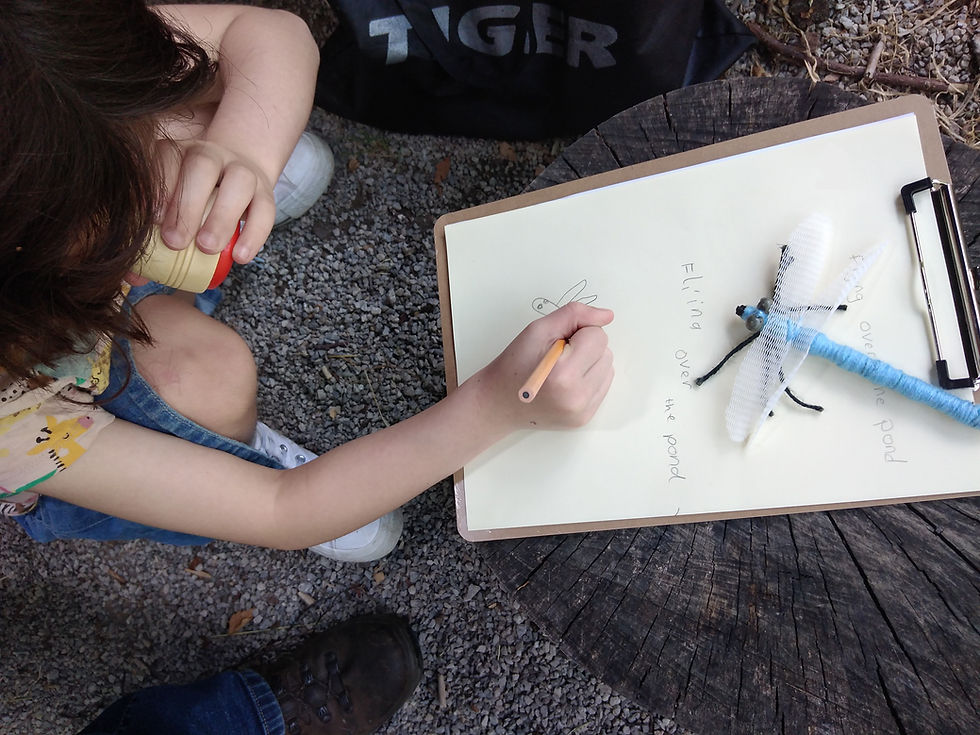Being Outside this Autumn
- Boom Blog

- Sep 2
- 2 min read
Written by : Eleri
Leader of the Whistlestop Wildlife Watch group. Offering nature-focused activities for families with children aged 4+ years.
Children often find themselves rushed along, hurried to be wherever they, or we, need to be. As grown-ups, we struggle to slow down. Autumn, though, encourages us to take our time. Unlike impetuous spring, autumn moves slowly, allowing summer to linger while also preparing, and preparing us, for the winter to come.
Wandering, we witness a gradual shifting as autumn paints new colours in the hedgerow, outdoing summer’s flowers. Rowan leaves in vibrant gold and the hawthorn’s robust reds contrast with the shocking pink of spindle berries, dramatic purple blackberries, and the more subtle indigo of early-season sloes.
We needn’t go far for autumn to ease us into a different pace of life; perhaps as well, as walking with young children can be less walk than stop - so many tiny treasures need investigating! Guided by children, endlessly curious, we often see more: a hazelnut nibbled by a wood mouse; or an interesting leaf, half green, half yellow.
Closing our eyes, we hear the natural world in a new way. Powerful, steady wingbeats of in-coming geese and the rapid whirring of a flock of redwings overhead whisper autumn, as do the soft thuds of bouncing acorns and conkers.
Small hands love smooth, shiny horse chestnut conkers, prised from soft-spined cases. Look too for chestnuts, smaller and flatter, their sharp, spikey cases reminding us of hedgehog prickles.
We can even enjoy the wild harvest. Gathering blackberries for jams and crumbles is an autumn treat. Raspberries too may still be found, and crab apples make terrific tiny toffee apples for late autumn festivals.

Some other wild fruits can be eaten but others are inedible, even poisonous to humans. We should never eat anything we cannot identify confidently and teach young children to ask us before tasting anything. Also it is important to remember the creatures who feast here and take no more than our share.
Unless you are an expert, fungi is best left untouched. Some species, while food for wild animals, are poisonous to us. Still we can marvel at their myriad forms, from the fabulously-named candlesnuff to the picture book favourite, fly agaric. There should still be some stinkhorns aroundtoo – justfollow your nose!
When neither walking nor stopping, children sense joyfully their bodies’ capabilities as they run, climb and balance. We can join them playing in crisp fallen leaves, or dancing to catch helicoptering sycamore seeds whirling towards the ground.
Shorter days shouldn’t keep us indoors. Darkness adds mystery, especially for children, for whom after-dark walks are a magical alternative to bedtime. Choose a nocturnal adventure to watch bats whizzing overhead, or to hear young tawny owls establishing their own new territories with hoos and kwiks.
We experience autumn most fully outdoors. Autumn landscapes, less showy perhaps than pumpkins and fireworks but no less spectacular, reveal something different each day. If we make time to explore the changing seasons, we root our children

If you would like to join a group or would like further information, please contact Eleri on whistlestop_watch@yahoo.com







Comments